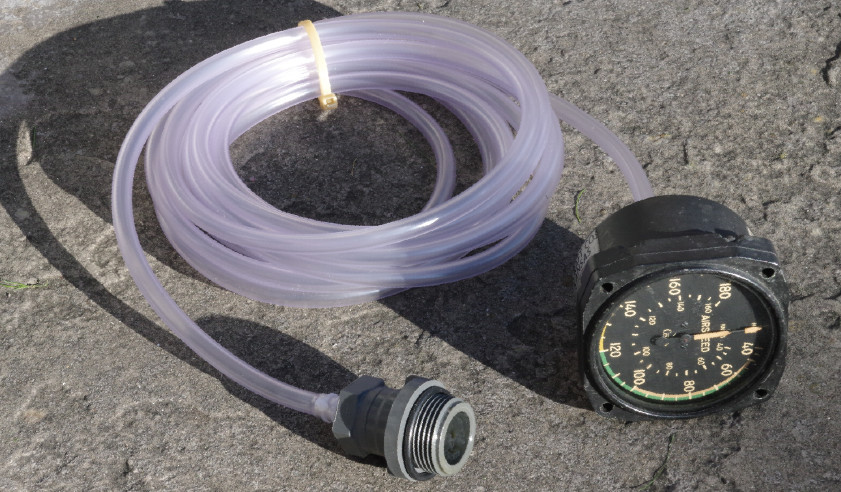I have managed to get up today for 1.5hrs airborne time and can confirm the 0W20 seems to have worked, in better than halving the oil loss.
Still more data is needed because 1.5hrs is not much. I am hoping to do Lausanne in early December. I am doing another service interval on the 0W20 (10% of the total oil; the other 90% being 1/2 W80 and 1/2 15W50) and by then it should be due for the Annual in January.
The oil filter was clean. I always open and examine it myself so I 100% know it has been done.
Peter wrote:
I always open and examine it myself so I 100% know it has been done.
Good on you !
I have done a flight and after landing, with the engine nice and warm, did the test with this screwed into the dipstick hole

The reading was 40kt at 1500rpm and 50kt at 1700rpm.
I could not do a higher rpm because it was hard to hold the door and if I closed the door totally it would have pinched the tube.
That PDF posted earlier says “90mph” (80kt) on this type of engine. It doesn’t say at what rpm. But I am within this because even at 2400rpm a linear extrapolation would be 70kt. Is there an SB or something for the IO540-C4 which gives this data? It’s bound to be dependent on how the crankcase breather is arranged, obviously.
Also the figure oscillated vigorously at the lower rpm – as one would expect. It got better at a higher rpm bit it does suggest that the 5m of 6mm ID tube should really be a much thinner tube, or have a restrictive orifice within it.
This device cannot be used on the TB20 airborne because you cannot close the oil filler door. One “could” still do it, because I “happen to know” that if you fly with the oil filler door accidentally not quite closed and it pops up during flight, nothing dramatic happens. But on that occassion I flew straight back; no point in taking a chance on the hinges staying in place. Also one would need a far more secure setup, with a thin tube, say 3mm OD, which can be adequately secured with duct tape and which can then pass through the door seal.
This US AOPA article doesn’t say anything about high altitude flight messing up the engine.
Peter, out of curiosity what CAS and fuel burn are you seeing at 14, 16, 18 thousand feet?
Looking back at some flights…
FL210: TAS135 IAS93 -25C 8.5GPH 1330F EGT 2575RPM pitch = 4deg UP
FL100: TAS150 +2C 10.5GPH 2400RPM
FL100: TAS153 +3C 10.5GPH 1500F EGT 2400RPM pitch = 2.5deg UP
This is just recent stuff. I would need more time to dig out more notes.
More:
FL100 +3C TAS153 10.5GPH
FL110 +7C TAS144 10.0GPH
FL120 +2C TAS140 9.5GPH
FL140 -8C TAS138 9.0GPH
FL150 -10C TAS140 8.5GPH
FL195 -38C TAS145 10.5GPH (BEST POWER I.E. 150F ROP)
I have another data point… Over the flight to Coventry and back, 1:45 airborne time, the oil level dropped from "9"+6mm to "9"+3mm.

It works out at 1qt in nearly 5 hours. That is historically my normal consumption and a ~ 3x improvement.
And I have not been flying it “hard” or anything like that, since I started running it with 1qt of Mobil 1 0W20. I did about 15hrs with this “additive”.
I wonder how many people did €10k top overhauls because their shop told them so…
Peter wrote:
It works out at 1qt in nearly 5 hours. That is historically my normal consumption and a ~ 3x improvement.And I have not been flying it “hard” or anything like that, since I started running it with 1qt of Mobil 1 0W20. I did about 15hrs with this “additive”.
Peter, that is really interesting experience. Given everything you’ve seen, what do you think is the probability that the synthetic, detergent oil cleaned everything up and fixed the issue? Or was it something else about the 1/2 quart of Mobil 1? Or a combination of factors including the oil?
On a slight tangent, my Lycoming O-320 was run a long time on auto fuel. The owner kept the plane at his house where Avgas was unavailable, so for him unleaded auto fuel was convenient and he had the STC . Now years later it runs on 100LL but I wonder whether low oil consumption and good compression today are helped by the existing cylinders being run on unleaded fuel for probably 500 hrs.
Peter wrote:
I have another data point… Over the flight to Coventry and back, 1:45 airborne time, the oil level dropped from "9"+6mm to "9"+3mm.
Trying to derive any hard data for oil consumption from such minute increments on the oil dipstick and such short flights is just about worthless, IMHO.
Here’s an excerpt from a Tech Article that explains this nicely:
So the reality is the uncertainty in “true” oil level is about a quart.